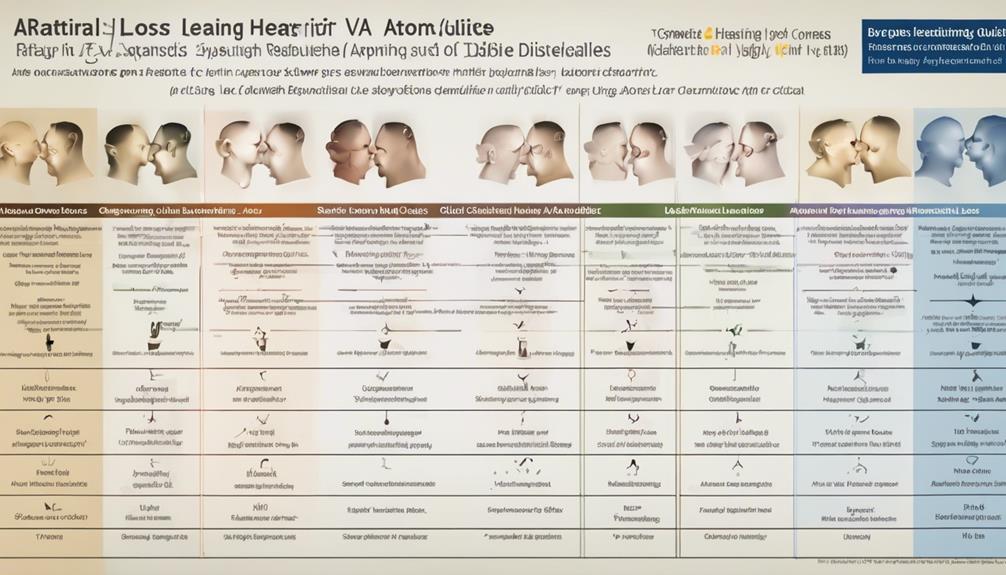Exploring the VA Rating Guide for Bilateral Hearing Loss highlights the importance of carefully assessing the impact of sound on both ears simultaneously. This process involves thorough testing methods and criteria, leading to a significant decision that greatly affects the lives of veterans.
However, beyond the initial evaluation lies a realm of considerations and possibilities that can shape the outcome in unexpected ways. Stay tuned to uncover the nuances and implications of this intricate rating system for bilateral hearing loss within the realm of VA benefits.
Key Takeaways
- VA utilizes a grid chart for impairment assessment.
- Single rating reflects overall bilateral hearing loss.
- Total hearing loss in both ears may qualify for SMC(k).
- Guidelines assist veterans in effectively seeking compensation.
Understanding Bilateral Hearing Loss Ratings
When assessing bilateral hearing loss ratings, the VA utilizes a grid chart to assign a Roman numeral designation for impairment. This grid chart aids in determining the level of disability incurred due to hearing loss in both ears. Veterans undergo specific hearing tests like Pure Tone Audiometry to assess their hearing abilities accurately.
Based on the results of these tests, a single rating is assigned for bilateral hearing loss, reflecting the overall impairment experienced. In cases where veterans suffer total hearing loss in both ears, they may qualify for Special Monthly Compensation (SMC(k)).
Understanding the intricacies of bilateral hearing loss ratings is crucial in ensuring that veterans receive the appropriate recognition and support for their service-related disabilities. By following the VA rating guidelines and comprehending the implications of the Roman numeral designation assigned through the grid chart, veterans can navigate the process of seeking compensation for their bilateral hearing loss effectively.
VA Criteria for Disability Evaluation

The VA's criteria for evaluating disability in cases of bilateral hearing loss involve conducting specific tests such as the Maryland CNC Test and Pure Tone Audiometric test to assess the severity of impairment in both ears. To determine the disability rating for veterans with bilateral hearing loss, the VA uses a grid chart that assigns a Roman numeral designation based on the degree of hearing impairment in each ear.
Veterans are then given a single rating for bilateral hearing loss, taking into account the combined impairment in both ears. This rating can range from 0 to 100, with higher ratings indicating more severe hearing loss. Veterans have the opportunity to provide additional evidence to support a higher disability rating if they believe their condition warrants it.
The VA's thorough evaluation process ensures that veterans with bilateral hearing loss receive appropriate compensation for their service-related disabilities.
Special Monthly Compensation Considerations
In considering Special Monthly Compensation (SMC) for veterans with bilateral hearing loss, the severity of impairment plays a crucial role in determining eligibility and additional financial support. SMC benefits, such as SMC(k), are designed to address the total loss of the sense of hearing in both ears, providing compensation beyond standard disability benefits.
Veterans with bilateral hearing loss may qualify for SMC benefits based on the severity of their impairment, which can range from partial to complete loss of hearing. These benefits aim to offer additional financial support to veterans coping with significant hearing disabilities. Eligibility for SMC compensation hinges on the extent of the hearing loss and its impact on the individual's daily life and functioning.
Total Disability Individual Unemployability (TDIU) and Hearing Loss

Considering the impact of Total Disability Individual Unemployability (TDIU) on veterans with hearing loss requires a thorough examination of eligibility criteria and documentation requirements. When it comes to TDIU and hearing loss:
- Eligibility Criteria: Veterans with a single disability rated at 60% or multiple disabilities totaling 70% (one being at least 40%) may qualify for TDIU benefits due to their hearing impairment.
- Financial Security: TDIU benefits offer veterans the opportunity to receive compensation at the 100% disability rate, significantly increasing their overall financial security and stability.
- Documentation: Providing evidence of unemployability specifically linked to hearing loss is crucial for TDIU claims. Supporting medical documentation that clearly shows the impact of the hearing impairment on the veteran's ability to work is essential for a successful application.
Understanding the nuances of TDIU and its relevance to veterans with hearing loss is vital in ensuring they receive the additional compensation they deserve for their service-connected disabilities.
Assistance With Hearing Loss Appeal
Navigating the complexities of VA disability rating appeals for bilateral hearing loss claims can be significantly aided by expert assistance from entities like Tuley Law Office. Seeking support from legal professionals can help veterans gather additional evidence, strengthen their appeal case, and potentially secure a higher disability rating. By engaging in the appeals process with specialized assistance, veterans increase their chances of a successful appeal and may maximize their compensation benefits. Tuley Law Office offers tailored services to guide veterans through the intricacies of appealing VA disability ratings for bilateral hearing loss, ensuring they receive the benefits they deserve. For veterans looking to enhance their appeal strategies and optimize their hearing loss disability ratings, reaching out to Tuley Law Office is a proactive step towards maximizing benefits.
| Benefits of Legal Assistance | Emotion in Appeal Process |
|---|---|
| Gathering Additional Evidence | Supportive |
| Strengthening Appeal Case | Empowering |
| Securing Higher Disability Rating | Encouraging |
Frequently Asked Questions
What Is the Average VA Rating for Bilateral Hearing Loss?
We typically see an average VA rating of around 10% for bilateral hearing loss. This rating is determined by specific tests like the Maryland CNC Test and Pure Tone Audiometric test to assess the severity of hearing loss in both ears.
Veterans have the opportunity to provide additional evidence to support a higher disability rating if needed. In cases of total hearing loss in both ears, there may be eligibility for Special Monthly Compensation (SMC(k)).
What Is Bilateral Minimal Hearing Loss?
We define bilateral minimal hearing loss as a mild impairment affecting both ears. It involves a slight difficulty in hearing soft sounds or whispers. Despite its subtle nature, individuals with this condition may face challenges in specific listening environments.
Treatment options typically include hearing aids or assistive devices. Understanding the nuances of bilateral minimal hearing loss can help provide appropriate support and accommodations for those experiencing this condition.
What Is the VA Rating for Bilateral?
When evaluating bilateral hearing loss, the VA considers impairment in both ears to determine a disability rating. Ratings can range from 0% to 100% depending on the severity of the condition. Tests like the Maryland CNC Test and Pure Tone Audiometric test are used for assessment.
Veterans with total hearing loss in both ears might qualify for Special Monthly Compensation (SMC(k)). Additional evidence can be submitted to support a higher disability rating.
What Are the VA Guidelines for Hearing Loss?
Sure!
VA guidelines for hearing loss are crucial for determining disability ratings. These guidelines utilize specific tests like the Maryland CNC Test and Pure Tone Audiometric test to assess hearing impairment levels.
The VA employs a grid chart to assign a Roman numeral designation based on the severity of the condition. Veterans can receive a single disability rating for bilateral hearing loss, considering factors such as speech discrimination, pure-tone thresholds, diagnosis, and etiology.
Conclusion
In conclusion, it's crucial for veterans with bilateral hearing loss to understand the VA Rating Guide and criteria for disability evaluation.
Did you know that approximately 60% of veterans receiving disability compensation for hearing loss have a rating of 0 to 40%?
This statistic highlights the prevalence of hearing impairments among veterans and the importance of seeking the appropriate compensation they deserve.











